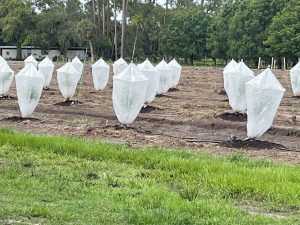You may have seen small trees in white shrouds on hills along the highways. They protect citrus trees from the Asian citrus psyllid and therefore, citrus greening disease.
New University of Florida research shows the trees grown under the individual protective covers (IPCs) also grow well for a few years after growers remove the bags.
Typically, after two to three years, growers remove the IPCs from trees. They then become exposed to the psyllid, which can transmit the deadly citrus greening disease. But this study showed the fruit continues to be healthy.

“We followed the trees for three years after we removed the IPCs, and we saw a clear improvement in fruit yield and quality, even though the trees were getting infected,” said Fernando Alferez, a UF/IFAS associate professor of horticultural sciences. “It’s worth mentioning that fruit quality declines over time after the covers are removed as the trees get infected, but it’s still superior to the fruit quality in the trees that are not covered.”
In this case, high quality means there’s more brix – a measurement of the amount of sugar – in the fruit.
Alferez and his colleagues also found that trees that were once protected by IPCs produce better quality fruit for 30 months after they’re planted. Because the fruit is of such high quality, growers can have an economic return as soon as two-and-a-half years after they plant the trees.
“This is not the case if trees are planted without protection,” said Alferez, a faculty member at the Southwest Florida Research and Education Center.
There are two reasons for this. First, it is highly improbable that trees not protected by IPCs can produce any fruit two-and-a-half years after planting, Alferez said. Even if they produce fruit, they have been infected for more than two years, so fruit quality will be poor.
For the past seven years, about 1,000 citrus growers have used IPCs to keep the psyllids off their trees, after Alferez tested them and provided sound scientific data showing they worked. Those growers represent what Alferez calls a significant portion of citrus farmers in Southwest and Central Florida.
For the better part of the past 20 years, Florida’s citrus growers have been looking for solutions to citrus greening disease, also known as Huanglongbing (HLB). The disease has damaged much of the state’s citrus, but UF/IFAS scientists are trying many methods to keep the industry alive and well. Currently, using IPCs is the best way to protect young trees from this disease.
###
ABOUT UF/IFAS
The mission of the University of Florida Institute of Food and Agricultural Sciences (UF/IFAS) is to develop knowledge relevant to agricultural, human and natural resources and to make that knowledge available to sustain and enhance the quality of human life. With more than a dozen research facilities, 67 county Extension offices, and award-winning students and faculty in the UF College of Agricultural and Life Sciences, UF/IFAS brings science-based solutions to the state’s agricultural and natural resources industries, and all Florida residents.
 0
0
